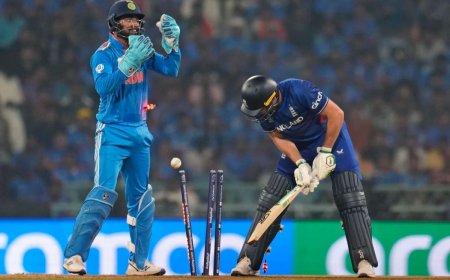Batting Strategy or Blunder? KL Rahul and Hardik Pandya at 6 and 7
India has kicked off the ODI series against England in dominant fashion, winning the first two matches convincingly. The team is showing great balance, adaptability, and match-winning performances across departments.
However, one key talking point remains—India’s batting order. With KL Rahul and Hardik Pandya slotted at No. 6 and No. 7, respectively, the question arises: Is this the best use of their batting prowess, or is India leaving too much firepower unused until too late in the innings?
KL Rahul at No. 6 – A Tactical Misstep?
KL Rahul is a class batter, someone who has excelled in various positions and formats. But seeing him come in at No. 6 feels like a waste of his abilities. A player of his caliber should ideally be batting higher, influencing the game rather than arriving too late to make a significant impact.

His current form hasn’t been the best, and one could argue that his lower batting position is contributing to this dip. For a batter who thrives on responsibility and rhythm, No. 6 is simply too low.
The Left-Right Obsession: Is Gambhir Overdoing It?
One of the key reasons behind this batting order shuffle is India’s insistence on maintaining a left-right batting combination in the middle order. Gautam Gambhir has been particularly firm on this approach, at times seemingly prioritizing it over individual player roles. His push to include Yashasvi Jaiswal at all costs nearly led to Shreyas Iyer being dropped—despite Iyer being a proven performer in the middle order.
This strategy also disrupted India’s well-set opening combination of Rohit Sharma and Shubman Gill, who have an outstanding ODI average of around 74. The proposed plan was to push Gill to No. 4 to accommodate Jaiswal at the top, with Virat Kohli at No. 3. However, breaking a successful opening pair could have hurt the team’s natural rhythm and stability.
Axar Patel at No. 5 – A Bold Move, But At What Cost?
Perhaps the most surprising decision of all has been Axar Patel’s promotion to No. 5. To his credit, Axar has delivered some impactful performances in this position, proving his ability to contribute with the bat. He has played two crucial innings, providing stability and momentum when needed against England. However, while his performances have been commendable, the bigger question remains—does this move strengthen India’s overall batting structure?
Axar at No. 5 means a player like KL Rahul, a specialist batter, gets pushed to No. 6, and Hardik Pandya, an elite batting all-rounder, finds himself at No. 7. This raises concerns about whether the team is utilizing its best batting resources in the most effective manner.
Hardik Pandya – Wasted at No. 7
Hardik Pandya is not just a finisher—he is a game-changer. His best utilization comes when he bats at No. 5 or No. 6, where he can pace the innings, take calculated risks, and turn games in India’s favor. Slotting him at No. 7 restricts his ability to face enough deliveries and impact the game as he should. If India wants to maximize Pandya’s batting potential, he needs to be moved up the order.
Is it Time to Play Rishabh Pant?
If India is determined to have a left-hander in the middle order, why not opt for Rishabh Pant? He is not only a natural left-hander but also a better wicketkeeper than KL Rahul. Slotting Pant at No. 5 would allow Hardik Pandya to bat at No. 6, followed by Axar and Ravindra Jadeja at No. 7 and No. 8. This would maintain the left-right balance without forcing top-quality right-hand batters too low in the order.
India has been performing exceptionally well in the series, but the team management must ensure that its best players are being used to their full potential. KL Rahul and Hardik Pandya batting at No. 6 and No. 7 seems like an underutilization of their skill sets. While Axar Patel’s promotion has worked so far, the bigger picture—team combination and batting order balance—needs to be reconsidered.
If India wants to continue its winning momentum, it must find the perfect balance between strategy and practicality. The best players should get the best opportunities, and team success should always come before rigid tactical preferences.
